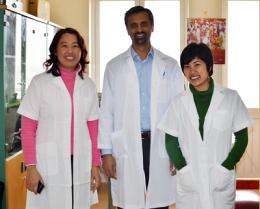Tracking and treating tuberculosis in developing countries

A patient in rural Uganda is diagnosed with tuberculosis (TB), but never begins treatment. In Hanoi, Vietnam, someone with infectious TB might never be diagnosed because the health center where she would go to be tested is too far away.
"Worldwide, only about half the number of TB cases that occur every year are actually detected and reported," said Adithya Cattamanchi, MD, a clinician at San Francisco General Hospital and Trauma Center (SFGH) and an assistant adjunct professor at the UCSF School of Medicine.
Cattamanchi is working to address challenges in Uganda and Vietnam by applying techniques of implementation science (ImS) learned through the Training in Clinical Research Program provided by UCSF's Clinical and Translational Science Institute (CTSI). ImS is focused on improving health by translating clinical findings into real-world interventions.
To diagnose TB, a health worker obtains a sputum specimen and smears it on a slide. A laboratory technician then examines the specimen under a microscope for evidence of TB. In conventional practice, a minimum of two specimens are required to confirm the diagnosis.
"Traditionally, we collect a specimen when the patient arrives, and then ask them to come back the next day and bring another specimen. Then they come back a third time to get results and start treatment if they're positive. Therein lies the problem," said Cattamanchi, who is also a CTSI KL2 Scholar.
In developing countries such as Uganda, up to half of all patients never come back to the health center after the first visit, because they live too far away and can't afford to take the time to return. "We asked how we could make the process more convenient for patients, so that they could complete testing and ideally begin treatment in one visit," he said. "We thought, what if we collected just one specimen and made two smears on two different slides? It turned out that we achieved the same level of sensitivity as the traditional method, but in one visit."
Cattamanchi and his team, including Luke Davis, an assistant adjunct professor in the UCSF School of Medicine, and Achilles Katamba, a lecturer at Makerere University in Uganda, are now testing several interventions in six Ugandan health centers to improve the quality of TB diagnosis and treatment:
- One involves same-day microscopy: "We want to know whether same-day microscopy is feasible in rural health centers, and actually results in more patients getting diagnosed with TB and starting TB treatment."
- Traditional light microscopes are being replaced with LED microscopes: "They're more sensitive, so you can view the slide at lower magnification, which makes it faster for the lab tech to read the smear. Plus, they're battery-powered so they don't depend on electricity."
- Finally, researchers are providing monthly report cards to clinic workers summarizing performance on quality indicators of TB evaluation: "The clinicians told us that no one was telling them how they were doing, but they had a hunger to know. They are now meeting on their own to decide how to address issues that come up, and we are measuring whether case detection and treatment initiation improve with this simple intervention."
Using Technology in Health Interventions
In Hanoi, Vietnam, while most people have access to neighborhood health posts, TB testing is only available at district health centers. There, Cattamanchi is working with Payam Nahid, MD, MPH, an associate professor in the UCSF School of Medicine; Daniel Fletcher, PhD, a professor of bioengineering at UC Berkeley; and Nguyen Viet Nhung, MD, PhD, vice-director of the Vietnam National Tuberculosis Program, to test a cell phone-based LED microscope that will decentralize the process of diagnosis.
"The health post worker collects the specimen, makes the smear, takes pictures of it with the microscope, and sends the images over the wireless network to the microscopist at the district health center, who reads the images and sends a text message with the results," Cattamanchi said.
Potentially, remote microscopy could be used throughout the developing world where wireless telecommunications networks are becoming ubiquitous, he added.
The project is also testing the impact of replacing traditional microscopy at the district health center level with a more sensitive and automated test developed by Cepheid of Sunnyvale, Calif., called GeneXpert, which identifies TB bacilli by their DNA. This type of test could previously only be performed in a developing country at the level of a national laboratory, he said.
"The training I received in implementation science has been essential to my work—specifically, in qualitative research methods, in designing less expensive studies that are still scientifically accurate, and in writing the rather specialized grants for this work," he said.
In support of efforts to apply ImS principles to global health problems, Cattamanchi is also involved in the Global Health Implementation Sciences Working Group managed by the Division of HIV/AIDS at SFGH. The group meets monthly to review ongoing or planned research projects in concert with a methodological expert.
Projects such as these "embody the type of research that we aim to support," said Ralph Gonzales, MD, a professor in the UCSF School of Medicine and director of CTSI's ImS program.
"Identifying barriers to change, employing new methodologies and skills, supporting collaborations, and achieving improvements in health care practices that are sustainable and reproducible in different settings: this is what implementation science is all about," he said.













